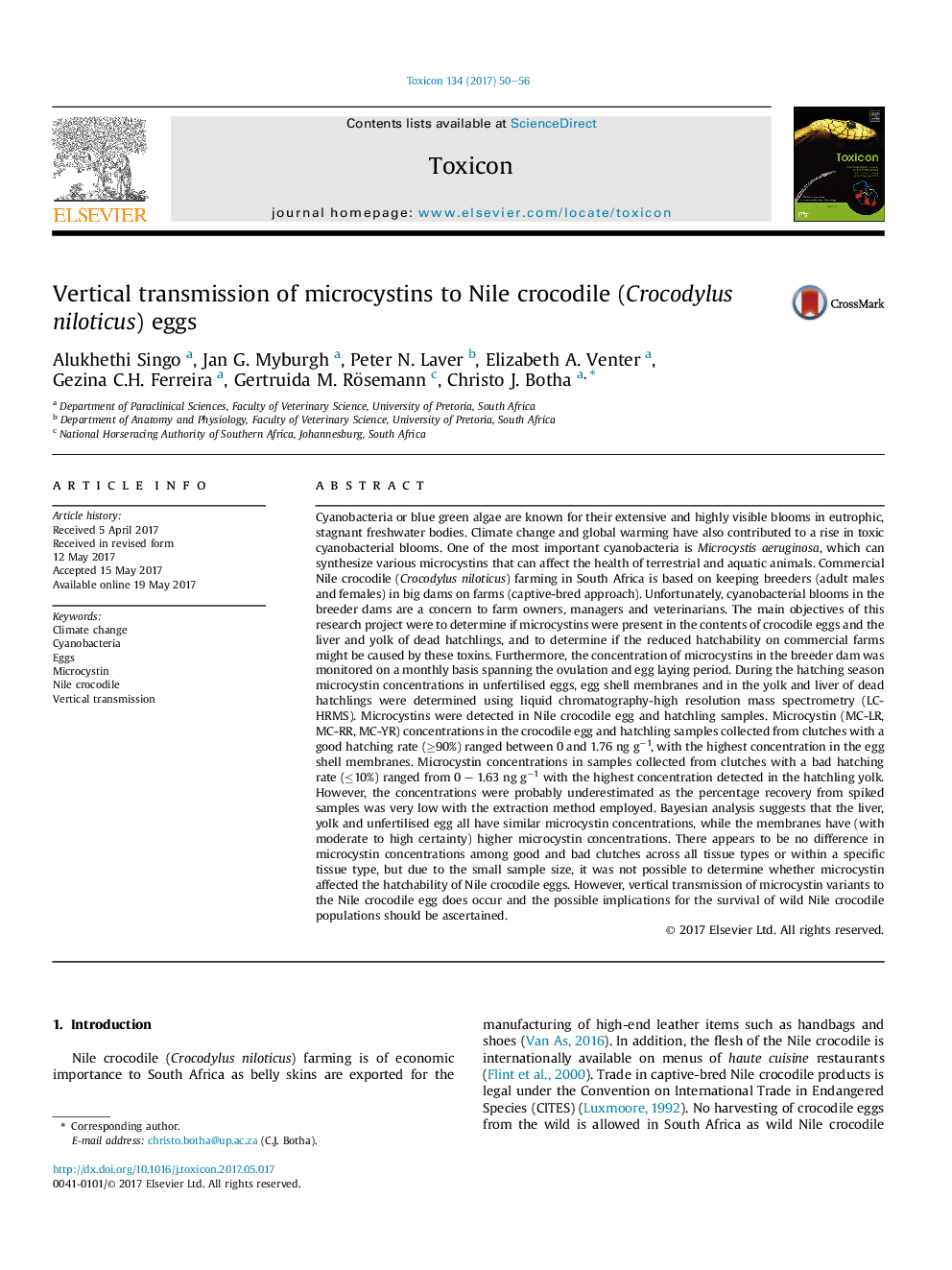| کد مقاله | کد نشریه | سال انتشار | مقاله انگلیسی | نسخه تمام متن |
|---|---|---|---|---|
| 5519235 | 1544102 | 2017 | 7 صفحه PDF | دانلود رایگان |

- Microcystin variants were detected in Nile crocodile egg and hatchling samples.
- Hatchling liver, yolk and unfertilised egg had similar microcystin concentrations.
- Egg-shell membranes contained higher microcystin concentrations.
- Vertical transmission of microcystin variants to the Nile crocodile egg occurs.
- Implications for the survival of wild Nile crocodile populations?
Cyanobacteria or blue green algae are known for their extensive and highly visible blooms in eutrophic, stagnant freshwater bodies. Climate change and global warming have also contributed to a rise in toxic cyanobacterial blooms. One of the most important cyanobacteria is Microcystis aeruginosa, which can synthesize various microcystins that can affect the health of terrestrial and aquatic animals. Commercial Nile crocodile (Crocodylus niloticus) farming in South Africa is based on keeping breeders (adult males and females) in big dams on farms (captive-bred approach). Unfortunately, cyanobacterial blooms in the breeder dams are a concern to farm owners, managers and veterinarians. The main objectives of this research project were to determine if microcystins were present in the contents of crocodile eggs and the liver and yolk of dead hatchlings, and to determine if the reduced hatchability on commercial farms might be caused by these toxins. Furthermore, the concentration of microcystins in the breeder dam was monitored on a monthly basis spanning the ovulation and egg laying period. During the hatching season microcystin concentrations in unfertilised eggs, egg shell membranes and in the yolk and liver of dead hatchlings were determined using liquid chromatography-high resolution mass spectrometry (LC-HRMS). Microcystins were detected in Nile crocodile egg and hatchling samples. Microcystin (MC-LR, MC-RR, MC-YR) concentrations in the crocodile egg and hatchling samples collected from clutches with a good hatching rate (â¥90%) ranged between 0 and 1.76 ng gâ1, with the highest concentration in the egg shell membranes. Microcystin concentrations in samples collected from clutches with a bad hatching rate (â¤10%) ranged from 0 - 1.63 ng gâ1 with the highest concentration detected in the hatchling yolk. However, the concentrations were probably underestimated as the percentage recovery from spiked samples was very low with the extraction method employed. Bayesian analysis suggests that the liver, yolk and unfertilised egg all have similar microcystin concentrations, while the membranes have (with moderate to high certainty) higher microcystin concentrations. There appears to be no difference in microcystin concentrations among good and bad clutches across all tissue types or within a specific tissue type, but due to the small sample size, it was not possible to determine whether microcystin affected the hatchability of Nile crocodile eggs. However, vertical transmission of microcystin variants to the Nile crocodile egg does occur and the possible implications for the survival of wild Nile crocodile populations should be ascertained.
204
Journal: Toxicon - Volume 134, August 2017, Pages 50-56